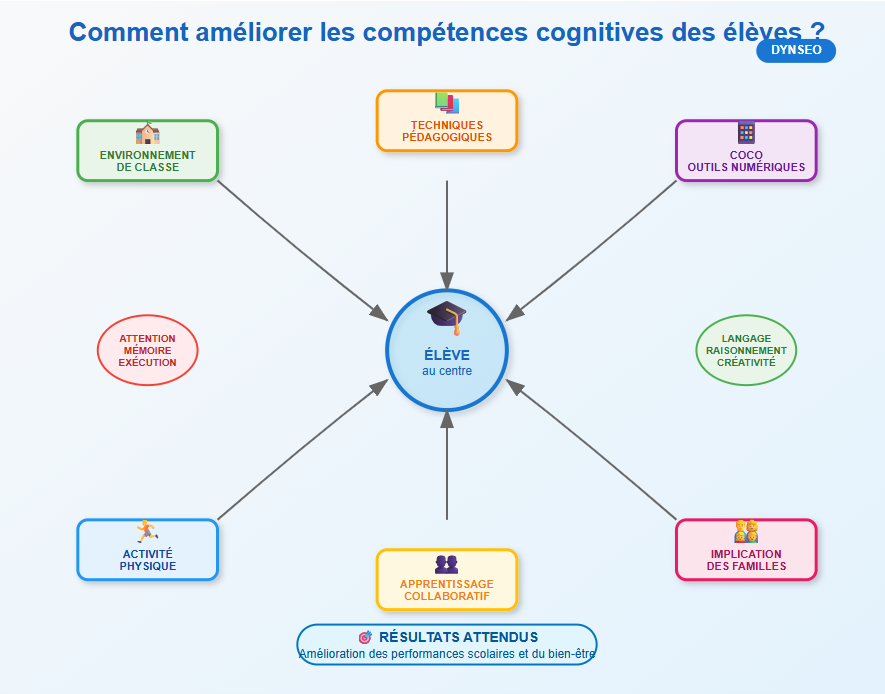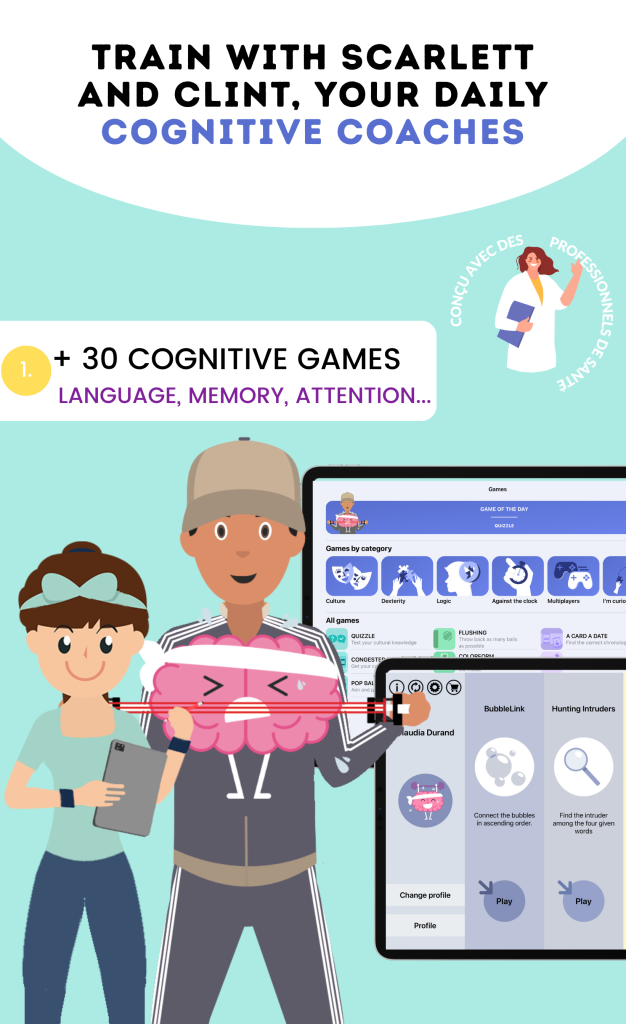In a constantly evolving world where academic and social challenges are becoming more complex, improving students’ cognitive skills represents a major issue for our education system. These fundamental skills – attention, memory, executive functions, language, and reasoning – are the pillars upon which all effective learning rests. Understanding how to develop and strengthen them can radically transform the academic and personal trajectory of children.
Research in cognitive neuroscience reveals that students’ brains, particularly plastic, offer exceptional opportunities for improvement. This brain plasticity, which is at its peak during childhood and adolescence, allows for the optimization of the neural circuits responsible for learning. However, this window of opportunity requires targeted, coherent, and scientifically-based interventions.
Contemporary Issues in School Cognitive Development
Today’s school faces unprecedented challenges. Students are evolving in an environment saturated with digital stimuli that fragment their attention and alter their cognitive habits. At the same time, academic demands are intensifying, requiring increasingly sophisticated skills in problem-solving, critical thinking, and information management.
Statistics reveal growing disparities in students’ cognitive performance. Some children naturally develop effective strategies, while others struggle to acquire the fundamental skills necessary for their success. This heterogeneity underscores the importance of a differentiated and personalized approach to cognitive development.
Attention disorders, memory difficulties, and deficits in executive functions are affecting an increasing number of students. These difficulties, often misunderstood or misinterpreted, can mask considerable potential and lead to avoidable academic failures. Hence, the urgency to implement effective preventive and corrective strategies.
Teaching Strategies to Enhance Attention and Concentration
Attention is the prerequisite for all learning. Improving students’ attentional capacity requires a multifaceted approach that combines environmental adjustments, specific teaching techniques, and targeted training.
The classroom environment plays a crucial role in maintaining attention. Reducing visual and auditory distractors, organizing the space in a structured way, and establishing clear routines allow students to better channel their concentration. Natural lighting, optimal temperature, and suitable acoustics are often overlooked but decisive factors.
Active teaching techniques promote attentional engagement. Alternating between short lectures and participatory activities maintains students’ interest. Regular brain breaks, integrated every 15-20 minutes depending on age, help restore attentional capacities. These breaks can include breathing exercises, light physical movements, or short playful activities.
Gamification of learning proves particularly effective in capturing students’ attention. COCO, our cognitive coach dedicated to children aged 5 to 10, perfectly illustrates this approach by transforming cognitive training into an engaging game. COCO’s colorful and progressive attention exercises allow students to develop their concentration while having fun, creating a positive association between cognitive effort and pleasure.
Memory Optimization Techniques Adapted to the School Context
Memory, the foundation of all learning, can be significantly improved through specific techniques. Explicit teaching of mnemonic strategies transforms students into autonomous and effective learners.
Scientifically validated spaced repetition techniques allow for optimal consolidation of knowledge. Instead of cramming before a test, students learn to spread their revisions over increasing intervals. This method, inspired by Ebbinghaus’s forgetting curve, multiplies memory efficiency by a significant factor.
Associating vivid mental images with information to be retained is a powerful strategy. Teaching students to create colorful, dynamic, and sometimes absurd visualizations significantly enhances memory encoding. This technique, particularly effective for vocabulary, historical dates, or scientific formulas, transforms rote learning into a creative process.
The method of loci, inherited from antiquity, allows for memorizing complex sequences by associating each element with a familiar place. Students learn to build mental pathways where each step corresponds to information to be retained. This technique proves highly effective for presentations, recitations, or learning procedures.
Organizing knowledge into mind maps facilitates understanding the links between concepts and improves memory retrieval. Teaching students to visually structure their lessons, using colors, symbols, and connections, transforms linear information into a network of interconnected knowledge.
Development of Executive Functions: Planning and Self-Regulation
Executive functions, often referred to as “leadership skills,” orchestrate all cognitive processes. Their development is a major predictor of students’ future academic and social success.
Explicit teaching of planning transforms disorganized students into effective strategists. Learning to break down a complex project into sequential steps, estimate the duration of each phase, and anticipate obstacles develops their autonomy. Visual tools like schedules, checklists, and simplified Gantt charts make this skill accessible even to the youngest.
Metacognition, or “thinking about thinking,” allows students to become aware of their own learning processes. Encouraging them to verbalize their strategies, identify their mistakes, and adjust their approach develops their self-regulation capacity. This reflexivity transforms failures into learning opportunities.
Cognitive inhibition, the ability to resist distractors and automatic responses, can be strengthened through specific exercises. Games that require inhibiting an impulsive reaction, such as “Simon Says” or its more sophisticated variants, develop this crucial skill for concentration and reflection.
The Educational Integration of Cognitive Digital Tools
The digital age offers unprecedented opportunities for personalized cognitive training. However, this integration requires a thoughtful approach that preserves the balance between technology and authentic human interactions.
COCO represents an exemplary example of a well-designed educational digital tool. Its 30 educational games, developed in collaboration with neuropsychologists, stimulate all cognitive skills while respecting individual learning rhythms. The colorful and intuitive interface perfectly adapts to the needs of children aged 5 to 10, transforming cognitive training into a moment of shared pleasure.
The advantage of digital tools lies in their ability to automatically adapt to each student’s level. COCO gradually adjusts the difficulty according to performance, maintaining an optimal level of challenge that promotes engagement without discouragement. This personalization, difficult to achieve in a traditional classroom context, allows each child to progress at their own pace.
The playful aspect of cognitive applications transforms the perception of mental effort. Instead of associating cognitive training with a constraint, students develop a positive relationship with intellectual challenge. This attitudinal shift is a powerful lever for long-term engagement in learning.
Collaborative Strategies and Peer Learning
Social interaction is a powerful driver of cognitive development. Collaborative strategies allow students to benefit from diverse approaches and develop their relational skills alongside their cognitive abilities.
Peer tutoring transforms advanced students into mentors and offers struggling learners personalized support. This approach benefits both parties: tutors reinforce their knowledge by explaining it, while tutees receive assistance tailored to their level of understanding.
Collaborative projects develop communication, negotiation, and collective problem-solving skills. Learning to distribute tasks, coordinate efforts, and integrate individual contributions into a common achievement prepares students for the challenges of the modern professional world.
Structured debates stimulate critical thinking and argumentation. Teaching students to construct coherent reasoning, anticipate counterarguments, and adapt their discourse to their audience develops their communication and reflection capabilities.
The Crucial Importance of Physical Activity and Well-Being
The link between physical activity and cognitive performance is well established. Regular exercise stimulates neurogenesis, improves cerebral vascularization, and promotes the production of neurotrophic factors essential for cognitive development.
Integrating short physical activities into the school day transforms students’ attention and concentration capacities. Ten minutes of movement can be enough to restore alertness and improve cognitive performance for several hours. These active breaks, far from being wasted time, constitute a profitable investment in learning quality.
COCO perfectly integrates this dimension with its mandatory sports break every 15 minutes of screen time. This feature, unique among educational applications, respects children’s physiological needs while creating a beneficial alternation between cognitive stimulation and physical activation.
Sleep is another fundamental pillar of cognitive development. Sleep-deprived students see their attention, memorization, and problem-solving capacities significantly reduced. Raising awareness among families about the importance of appropriate sleep hygiene is a lever for cognitive improvement that is often overlooked but essential.

cognitive school skills of students with DYSNEO
Personalization and Differentiated Teaching
Each student presents a unique cognitive profile, with specific strengths and weaknesses. Personalizing cognitive training allows for maximizing each individual’s potential while addressing identified gaps.
Initial assessment of cognitive skills allows for establishing an accurate profile of each student. This cognitive mapping guides subsequent interventions and allows for objective tracking of progress. Modern assessment tools, integrated into platforms like COCO, facilitate this diagnostic process.
Adapting exercises to each student’s learning style optimizes training effectiveness. Some children benefit more from visual approaches, while others from auditory or kinesthetic activities. This methodological diversification respects neurodiversity and maximizes engagement for all learners.
Family Involvement and Educational Continuity
Improving cognitive skills cannot be limited to the school context. Family involvement and continuity between school and home are determining factors for success.
Training parents on cognitive issues transforms the family environment into a space for complementary stimulation. Explaining to families the importance of cognitive functions and providing them with simple tools to stimulate them daily multiplies the impact of school interventions.
Cognitive family activities strengthen emotional bonds while developing skills. Board games, shared puzzles, discussions on current events, or joint creative projects provide numerous opportunities for natural and enjoyable cognitive stimulation.
COCO facilitates this family involvement through its intuitive interface that allows parents to accompany their children in their cognitive training. Shared progress reports create a constructive dialogue between teachers, parents, and students around learning.
Evaluation and Monitoring of Cognitive Progress
Improving cognitive skills requires rigorous monitoring to adjust interventions and maintain motivation. Modern assessment tools allow for precise and objective monitoring of progress.
Regular assessments, naturally integrated into learning activities, avoid the stress of traditional tests while providing valuable data. This continuous evaluation allows for quickly identifying emerging difficulties and adapting interventions in real-time.
Visualizing progress motivates students and enhances their sense of personal effectiveness. Progress graphs, achievement badges, and personalized challenges transform cognitive improvement into an exciting adventure where each step is a celebrated victory.
Conclusion: Towards a Holistic Approach to Cognitive Development
Improving students’ cognitive skills requires a systemic approach that integrates innovative pedagogy, adapted technological tools, family involvement, and attention to overall well-being. This holistic approach recognizes that optimal cognitive development emerges from the harmonious interaction between biological, environmental, and social factors.
Tools like COCO represent valuable allies in this mission, but they cannot replace the authentic pedagogical relationship and the personal commitment of each educational actor. The challenge lies in intelligently orchestrating pedagogical tradition and technological innovation to offer each student the best chances to develop their cognitive potential.
Investing in the cognitive development of students is a major societal issue. Training citizens capable of thinking critically, solving complex problems, and adapting to the constant changes in our world represents the educational challenge of the 21st century. This demanding yet exciting mission requires the coordinated commitment of all educational actors to build the cognitive school of tomorrow.
Useful Resources for Cognitive Improvement
Practical Tools for Teachers
Educational applications and platforms:
- COCO: Comprehensive cognitive stimulation app for children aged 5-10 with over 30 educational games
- Lumosity: Brain training platform with progress tracking
- Peak: Short and varied cognitive games suitable for class breaks
- Elevate: Targeted exercises on fundamental academic skills
Educational resources:
- Practical guide “Executive Functions in the Classroom” from the Transfer Center for Educational Success in Quebec
- Educational kit “Attention and Learning” from INSERM
- Cognitive activity kit from the Institute of Learning Disabilities in Canada
- Free cognitive stimulation resources on the Éduscol portal
Physical Materials and Games
Cognitive board games:
- Set: development of mental flexibility and visual attention
- Rush Hour: planning and solving sequential problems
- Dobble: processing speed and selective attention
- Timeline: memory and temporal organization
- Concept: development of language and creativity
Manipulative materials:
- Logical blocks for spatial reasoning
- Tangrams for visual-spatial perception
- Blank mind maps for organizing ideas
- Visual timers for time management
- Reward charts for positive reinforcement
Training and Certifications
Continuing education for teachers:
- Certificate in Educational Neuroscience (University of Montreal)
- Training “Brain and Learning” (CANOPÉ)
- MOOC “Learning and Teaching” (UCLouvain)
- DYNSEO seminars on the integration of digital cognitive tools
Resources for families:
- Parent-child workshops on cognitive functions
- Practical guides for cognitive stimulation at home
- Monthly webinars on cognitive development
- Online community for sharing educational experiences
Scientific References and Authority Links
Fundamental Research in Educational Neuroscience
The work of Stanislas Dehaene (Collège de France) on the cognitive neuroscience of learning is an essential reference. His research demonstrates the importance of attention, active engagement, and feedback in learning processes. The book “Learning! The Talents of the Brain, the Challenge of Machines” perfectly synthesizes these discoveries for the educational world.
The Institut Pasteur and its cognitive neuroscience laboratory led by Ghislaine Dehaene-Lambertz produce essential research on early cognitive development. Their work on childhood brain plasticity sheds light on best pedagogical practices for young learners.
International Reference Organizations
The OECD (Organisation for Economic Co-operation and Development) regularly publishes reports on the effectiveness of educational systems. The project “Understanding the Brain: The Birth of a Science of Learning” establishes concrete bridges between neuroscience and pedagogy.
The UNESCO develops specific programs on neuroscience applied to education through its International Institute for Educational Planning. Their recommendations influence global educational policies.
The Harvard Center on the Developing Child led by Jack Shonkoff produces benchmark research on the development of executive functions in children. Their free publications offer accessible summaries for practitioners.
French Institutions of Excellence
The INSERM (National Institute of Health and Medical Research) maintains a research unit specializing in children’s cognitive disorders. Their work on dyslexia, attention disorders, and learning difficulties provides solid scientific foundations for pedagogical interventions.
The CNRS (National Center for Scientific Research) hosts several leading laboratories in cognitive neuroscience. The Marc Jeannerod Institute of Cognitive Sciences in Lyon produces applied research particularly relevant to education.
Reference Scientific Journals
Educational Psychology Review publishes meta-analyses on the effectiveness of cognitive interventions in school settings. This leading journal regularly synthesizes best practices based on evidence.
Mind, Brain, and Education is THE reference journal for bridges between neuroscience and education. Founded by the International Mind, Brain, and Education Society, it translates scientific discoveries into practical applications.
Journal of Cognitive Enhancement specializes in evaluating cognitive training programs. Its articles provide a critical analysis of cognitive improvement tools and methods.
Databases and Meta-Analyses
The Campbell Collaboration maintains a database of systematic reviews on the effectiveness of educational interventions. Their rigorous syntheses guide pedagogical decisions based on evidence.
The Education Endowment Foundation in the UK funds and evaluates innovative educational programs. Their “Teaching and Learning Toolkit” ranks interventions based on their proven effectiveness and cost-benefit ratio.
Applied Expertise Centers
The Center for Applied Neuroscience at the University of Dallas develops scientifically validated cognitive training programs. Their protocols inspire the best educational applications like COCO.
The Institute of Learning Disabilities in Canada produces practical resources directly usable by teachers. Their assessment and intervention tools are recognized internationally.
The Interdisciplinary Research Center (CRI) in Paris experiments with new pedagogies based on cognitive sciences. Their pedagogical innovations influence the evolution of educational practices.




